Starting with the letter “S,” this article covers 40 fabulous flowers that are great additions to gardens. You’ll find popular annuals like sunflowers and snapdragons next to perennial favorites like Shasta daisies and soapwort.
The blooms featured come in all colors of the rainbow and span flowering seasons from early spring bulbs to fall mums. Whether you want to attract pollinators, cut fresh bouquets, or simply add charm to your yard, you’re sure to find an “S” flower perfect for your needs.
Some offer medicinal uses, edible parts, or serve as wildlife habitat. Getting up close with these diverse flowers starting with S, you’ll learn key facts about their appearance, growing needs, and how to best use them in your landscape.
Let’s dive in and explore 40 sensational flowers that start with the letter S!
Annual Flowers that Start with S
Following is a list of annual flowers that start with S.
Silene
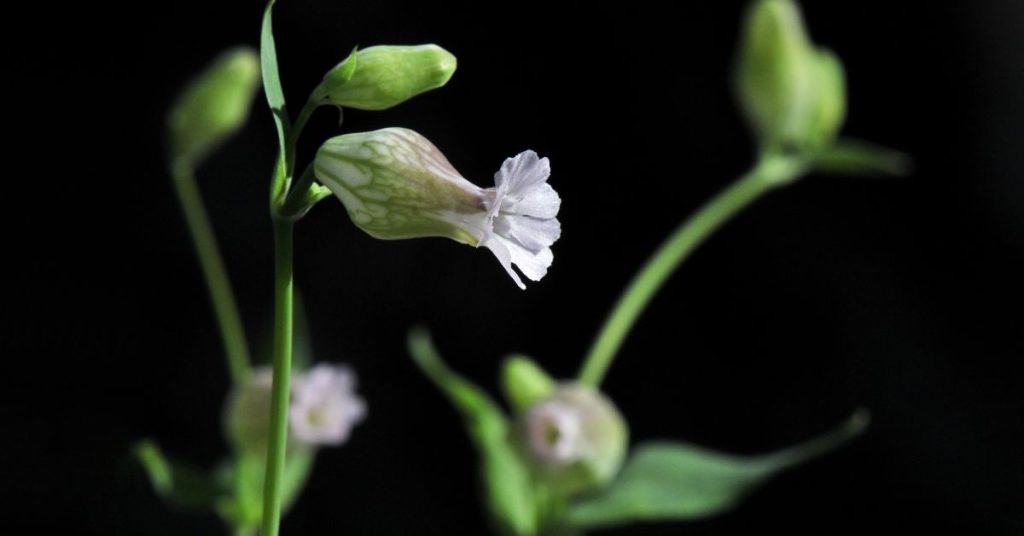
Also known as catchflies, Silene is a genus of flowering plants in the pink family Caryophyllaceae. There are over 700 species of Silene, and many have fragrant, star-shaped flowers in white, pink, red, or purple. Some popular Silene flowers include:
- Red Campion – This perennial Silene has frilly, deep red blooms from late spring to summer. It grows 1-3 feet tall.
- White Campion – A clump-forming perennial with white, fringed flowers that bloom in summer. Grows 2-3 feet tall.
- Fire Pink – A North American native wildflower with bright pink-red blooms in spring. Grows 1-2 feet tall.
- Bladder Campion – Has inflated, balloon-like calyces behind its white flowers. Grows 1-2 feet tall.
Siberian Larkspur
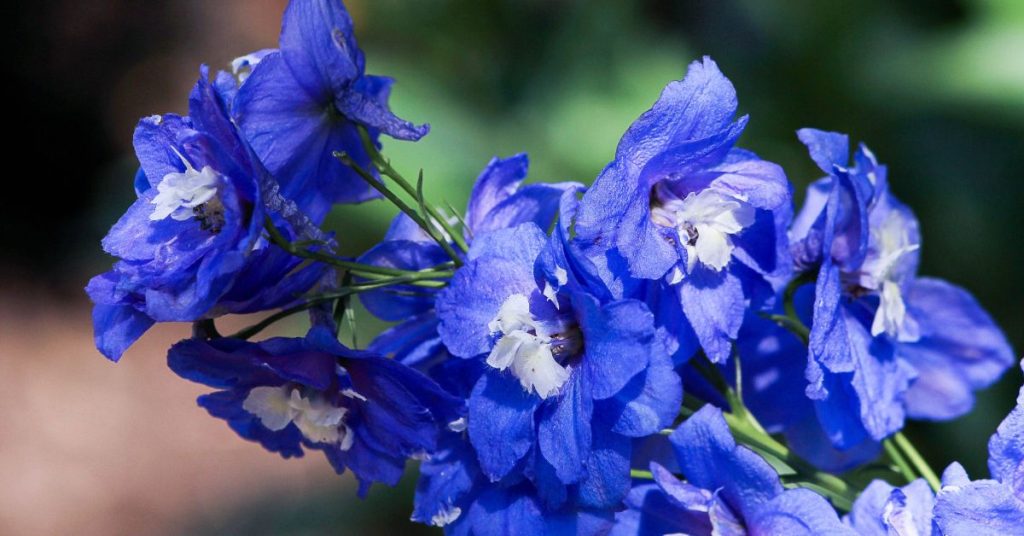
Siberian larkspur, also called Turkestan larkspur, is a tall perennial flower in the buttercup family. Native to Central Asia, it produces spikes of bright blue flowers on 4-5 foot stems in late spring/early summer. Some details about Siberian larkspur:
- Thrives in full sun and well-drained soil. Drought tolerant once established.
- Looks beautiful in perennial borders, cut flower arrangements, and cottage gardens.
- Toxic if ingested, so plant with care if you have pets or children.
- Available in darker or lighter blue flower varieties such as Dark Knight and Blue Bird.
- Divides easily every 2-3 years in fall to propagate.
Snapdragon
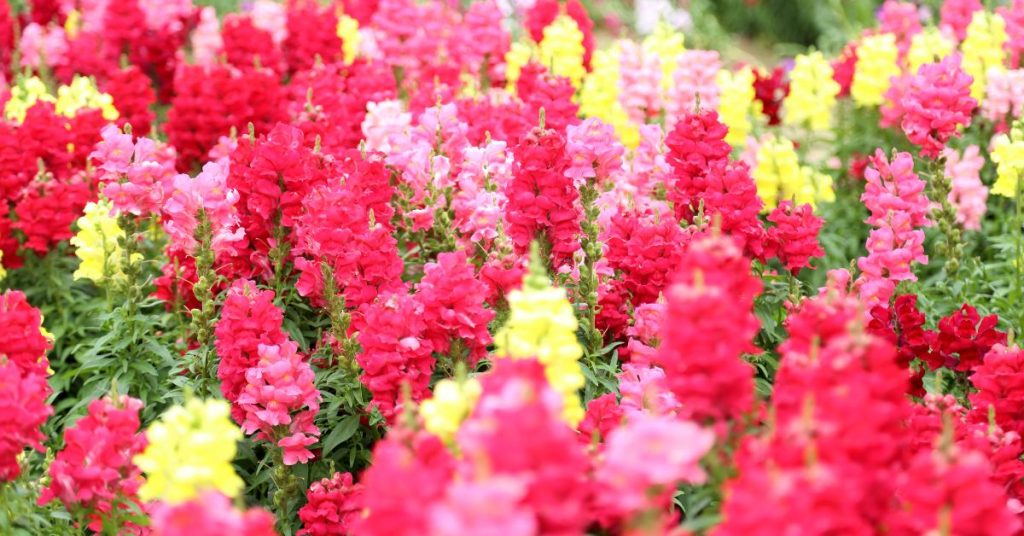
Snapdragon is the common name for members of the Antirrhinum genus, upright perennials with colorful, tubular flowers reminiscent of dragon mouths that open and close when squeezed. Popular snapdragon flower facts:
- Native to US, Europe, North Africa. Grow as annuals or perennials in zones 7-10.
- Come in shades like white, yellow, pink, red, purple, peach, orange. Bicolors exist too.
- Grow 1-3 feet tall on upright stems. Dwarf and trailing varieties available.
- Blooms in cool weather, spring through fall. Deadhead spent flowers for more blooms.
- Does well in containers, borders, rock gardens. Needs full sun.
- Tolerates heat and drought once established. Provide good drainage.
- Few problems with pests or diseases. May get aphids, powdery mildew, or fungal issues.
Sunflower
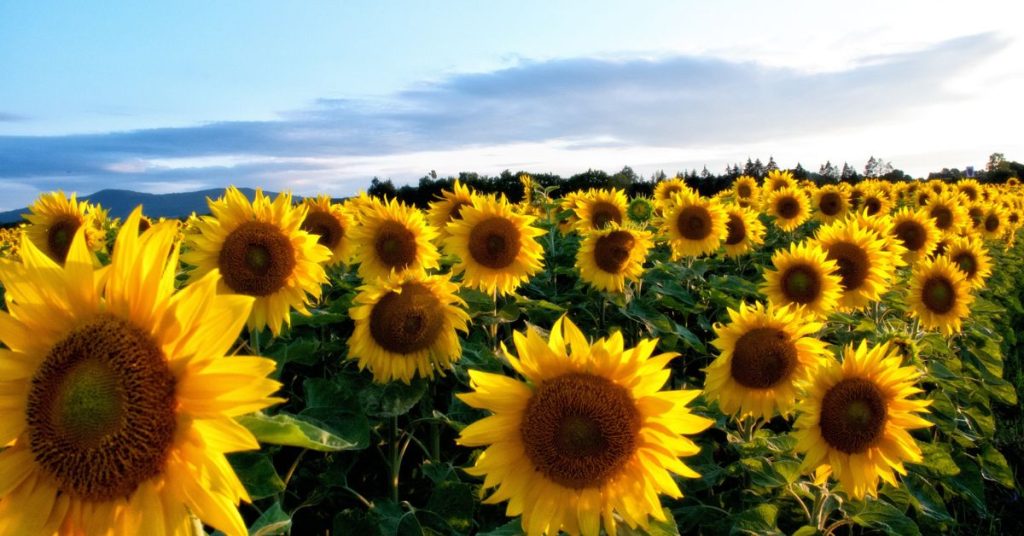
Sunflowers are native North American flowers, and the state flower of Kansas. Some key facts:
- Annuals that come in a huge range of sizes – from 2 feet to 12+ feet tall!
- Feature bright yellow ray flowers circling a brownish-yellow disk center.
- Bloom in summer to early fall. Require full sun and average to dry soil.
- Varieties include traditional yellow, red/burgundy, and multicolored.
- Pollinator favorites! Attract bees, butterflies, and birds.
- Seed-producing sunflowers have edible seeds that are nutritious. Popular snack!
- Make cheery cut flowers. Dwarf varieties work well in containers.
- Easy to grow from seed after frost. Sow 1 inch deep, 6 inches apart.
Spider Flower
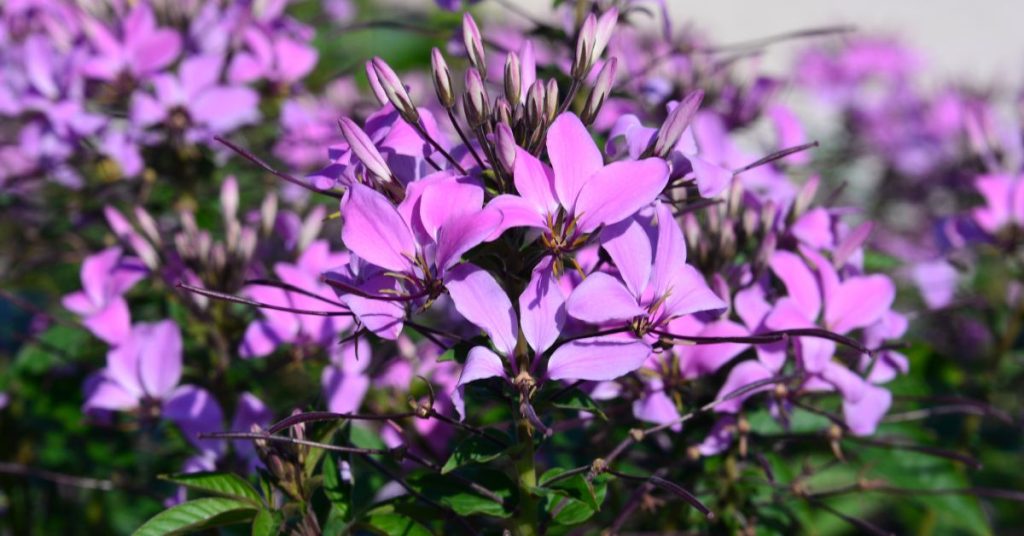
Spider flowers, genus Cleome, are tall dramatic annuals that add vibrant color and unique flair to summer gardens. Here’s an overview:
- Produce spider-like flowers with long stamens and oval petals in pink, purple, white or combinations.
- Grow 3-5 feet tall on branching stems. Have a lanky habit. May need staking.
- Bloom from early summer into fall. Deadhead for more flowers.
- Prefer full sun and average to dry conditions. Reseeds readily.
- Cleome hassleriana is the most common species. Varieties offer more compact size and new colors.
- C. spinosa has prickly seed pods. Handle carefully.
- Attracts hummingbirds and pollinators all season long with its nectar-rich flowers.
Scaevola
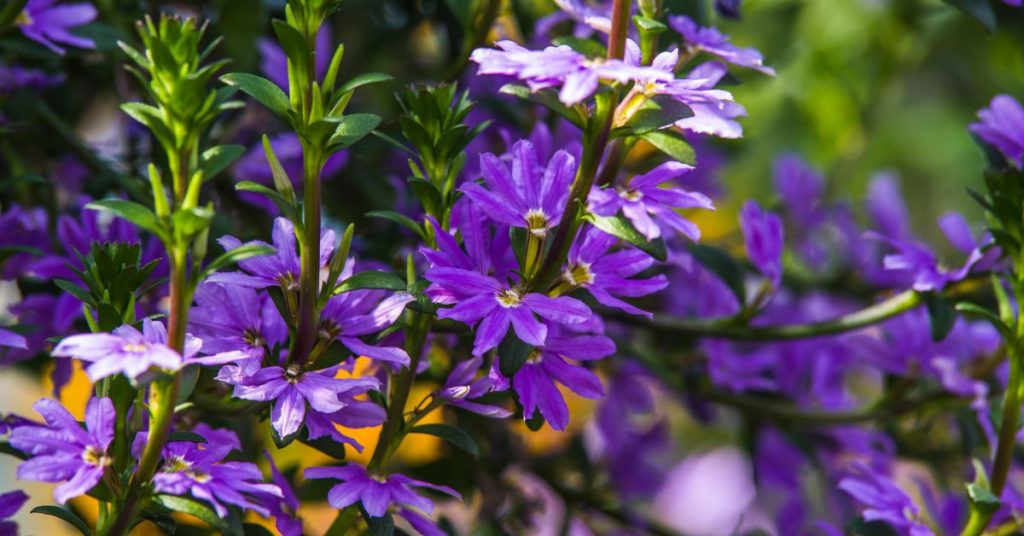
Scaevola, also called fanflowers, are tropical perennials grown as annuals with unique, fan-shaped blossoms. Details:
- Native to Australia. Thrives in hot, humid summers.
- Flowers have half-circular, layered petals in white, blues, purples or pinks.
- Compact, mounding plants grow 6-12 inches tall and wide. Cascading varieties available.
- Blooms continuously spring through frost. Deadhead to prolong flowering.
- Does well in containers, hanging baskets, borders and beds. Needs good drainage.
- Attracts butterflies and hummingbirds!
- Requires full sun and weekly watering. Tolerates drought once established.
- Few problems with pests or diseases. Provide winter protection in zone 9 and up.
Safflower
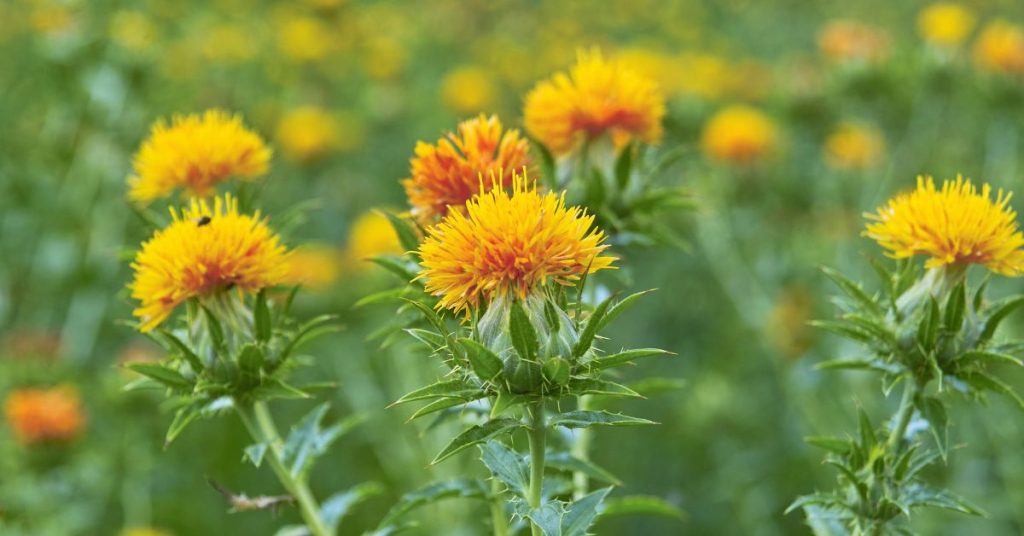
Safflower is an ancient oilseed crop grown for its edible oil and use as birdseed and livestock feed. Flower facts:
- An annual thistle-like plant that grows 1-4 feet tall.
- Features prickly leaves and heads of small orange, red, or yellow flowers.
- Blooms in summer and can be grown as an ornamental.
- Prefers full sun and adapts to many soil types and growing conditions.
- The Safflower seeds are the primary interest for commercial growers.
- The oil from safflower seeds is flavorless and high in healthy fats. Used for cooking, salad dressings, etc.
- The vibrantly colored flowers attract pollinators before going to seed.
- Tea can also be made from the safflower petals and leaves.
Sweet alyssum
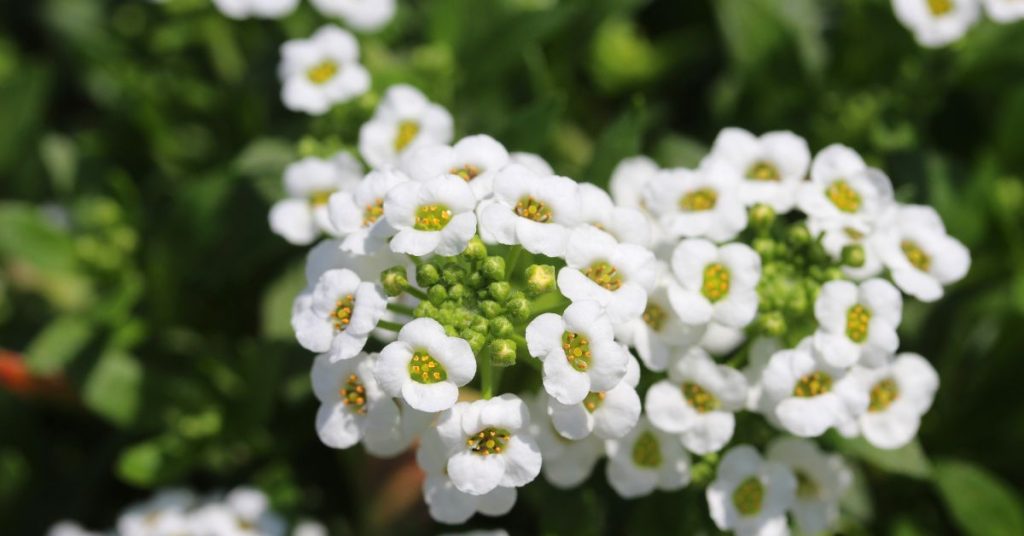
Sweet alyssum is a fragrant annual flower that blooms all summer long. Details:
- Part of the Brassicaceae family along with mustards, cabbage and radish.
- Native to Europe and grown as an ornamental for its sweet-smelling white or purple flowers.
- Blooms Spring through Frost. Deadhead to encourage more flowers.
- Grows just 4-6 inches tall, spreading into a low carpet of blossoms.
- Thrives in full sun. Needs good drainage. Drought tolerant.
- Looks lovely in containers, borders, rock gardens, and mixed flower beds.
- Attracts bees, butterflies and other pollinators. Supporter of beneficial insects.
- Requires minimal care. May reseed each year. No serious pest or disease problems.
Perennial Flowers that Start with S
Following is a list of perennial flowers that start with S.
Salvia Splendens
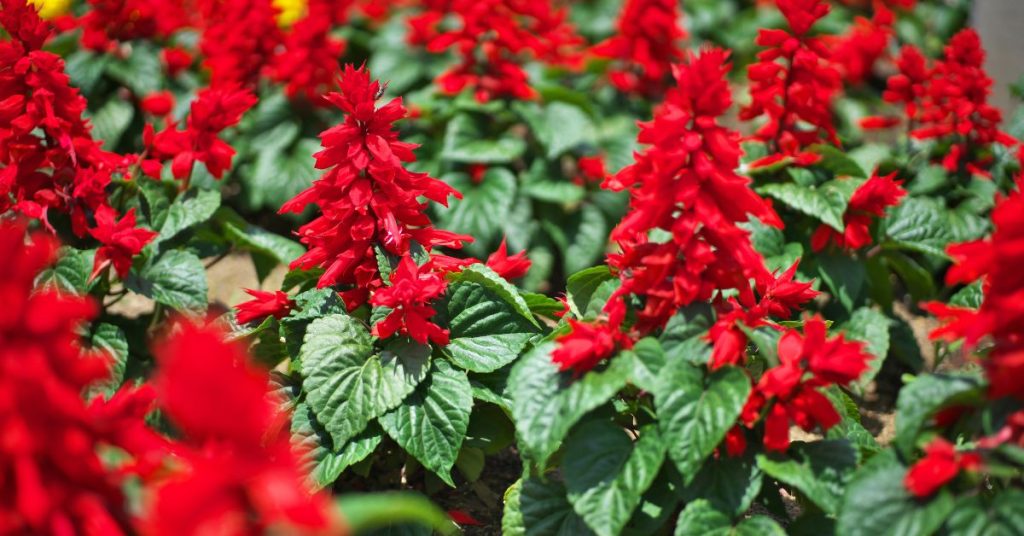
Salvia splendens, commonly called scarlet sage, is a popular warm-season annual with vibrant red, tubular flower spikes. Facts:
- Native to tropical regions of South America.
- Grows 1-3 feet tall on upright, square stems. Bushy form.
- Produces flower spikes almost continuously summer through fall frost. Deadhead to prolong bloom.
- Does best in full sun and average, well-draining soil. Needs moderate water.
- Looks beautiful massed in garden beds and containers. Attracts hummingbirds!
- Other salvia splendens varieties offer coral, pink, white, purple or bicolor blooms. ‘Sizzler Red & White’ is a showy bicolor type.
- No serious pest or disease problems. Watch for aphids, whiteflies, fungal disease if overwatered.
St. John’s Wort Plant
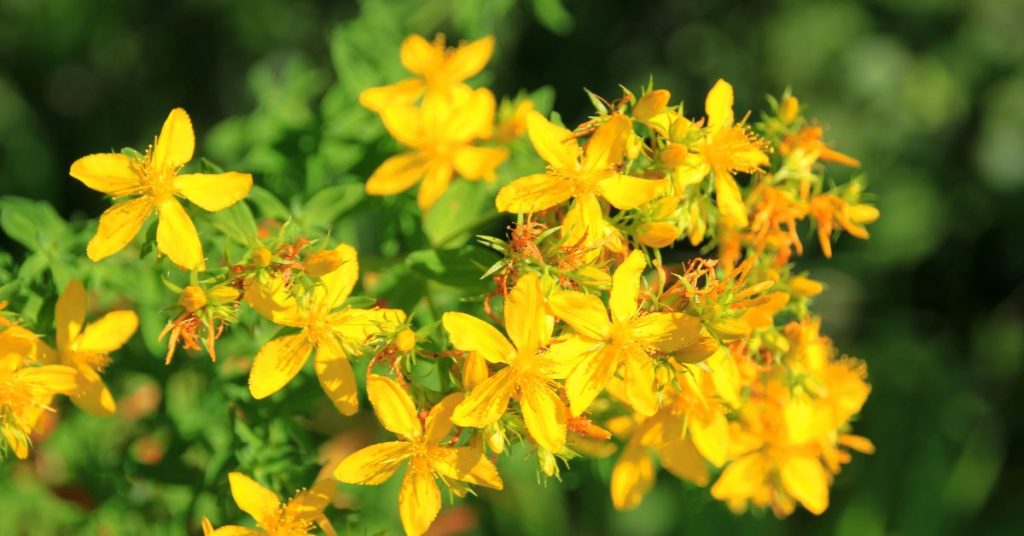
St. John’s wort is a perennial herb with cheery, bright yellow flowers. Other facts:
- Grows 1-3 feet tall on bushy plants. Spreads through rhizomes underground.
- Features abundant star-shaped flowers with prominent stamens. Blooms in summer.
- Thrives in full to partial sun and average to dry soils. Does well near coasts.
- Used historically for medicinal purposes. Research effectiveness and safety first.
- Can be aggressive spreader. Keep under control or grow in containers.
- Avoid ingesting the plant. Can cause photosensitivity. Keep away from livestock.
- No serious problems with pests or disease. Deer tend to avoid this plant.
- Good for the back of borders and cottage gardens. Prune back after flowering.
Sundrops
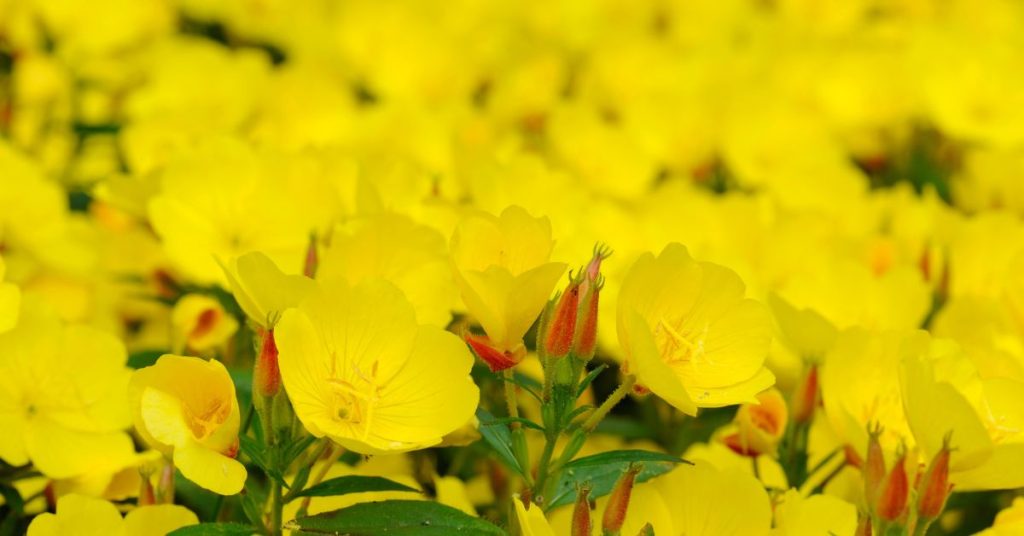
Sundrops, also called evening primrose, are cheery North American native flowers that bloom in summer. Details:
- Bright yellow, saucer-shaped flowers open during the day, unlike primroses that open at night.
- Grow 1-3 feet tall on branching herbaceous plants with lance-shaped leaves.
- Prefer full sun to part shade. Tolerate a range of soils, even poor ones. Drought resistant.
- Often grown as biennials or short-lived perennials. May self-sow.
- Good choices for meadow, prairie, or wildflower gardens. Attracts butterflies.
- Varieties offer larger blooms, fuller habit, or longer flowering period. ‘Sundrop Bouquet’ has abundant big flowers.
- Medicinal uses include anti-inflammatory properties. Leaves and shoots are edible.
Saponaria
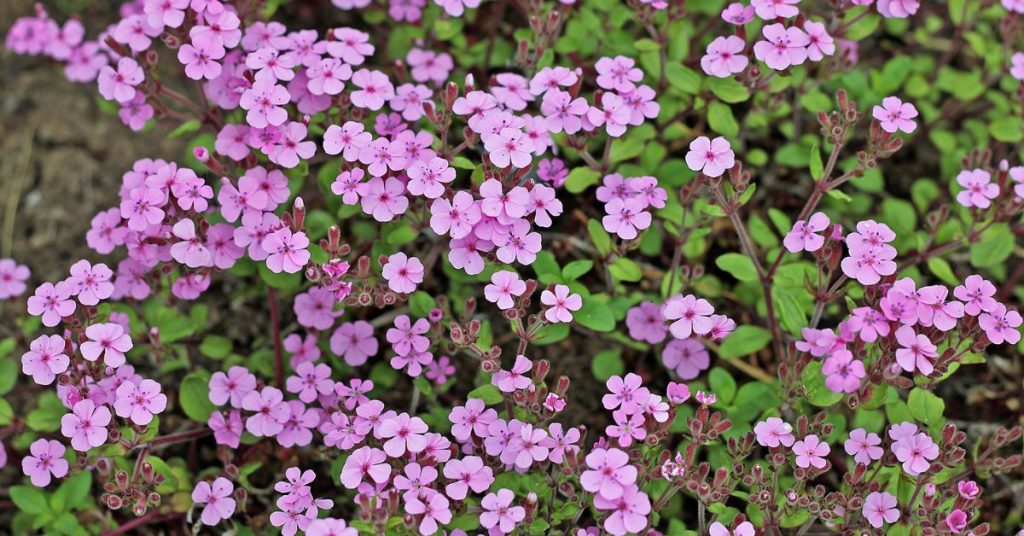
Saponaria, also called soapwort, is an old-fashioned perennial flower known for its pretty clusters of 5-petaled blooms. Facts:
- Features white or pink flowers on 1-2 foot tall, mounding plants. Bloom in summer.
- Native to Europe and Asia. Does well in full sun to part shade.
- Works nicely in rock gardens, cottage gardens, and borders. Attracts butterflies!
- Varieties offer single or double blooms, in shades of white, pink, and rose.
- Used historically as a gentle soap and detergent replacement.
- Can be aggressive spreader. Contain or limit self-seeding.
- Tolerates poor, dry soils. Provide good drainage to prevent root rot.
- Minimal maintenance. Pinch back spent blooms to encourage reblooming.
Snow-in-Summer

Snow-in-summer is a low-growing perennial flower that forms a mat of green leaves covered in tiny white blooms. Details:
- Botanical name Cerastium tomentosum – part of the carnation family.
- Grows just 3-6 inches tall and spreads 1-2 feet wide. Compact, mounding habit.
- Features gray-green wooly leaves and masses of small, starry white flowers in summer.
- Does well in full sun and drier soils. Requires little water once established.
- Looks nice spilling over walls, in rock gardens, front of borders, and containers.
- Tolerates light foot traffic. Use as a lawn substitute between pavers or stones.
- Attracts bees and butterflies. Deer and rabbit resistant perennial.
- Can be aggressive spreader. Control growth to keep contained.
Star of Bethlehem
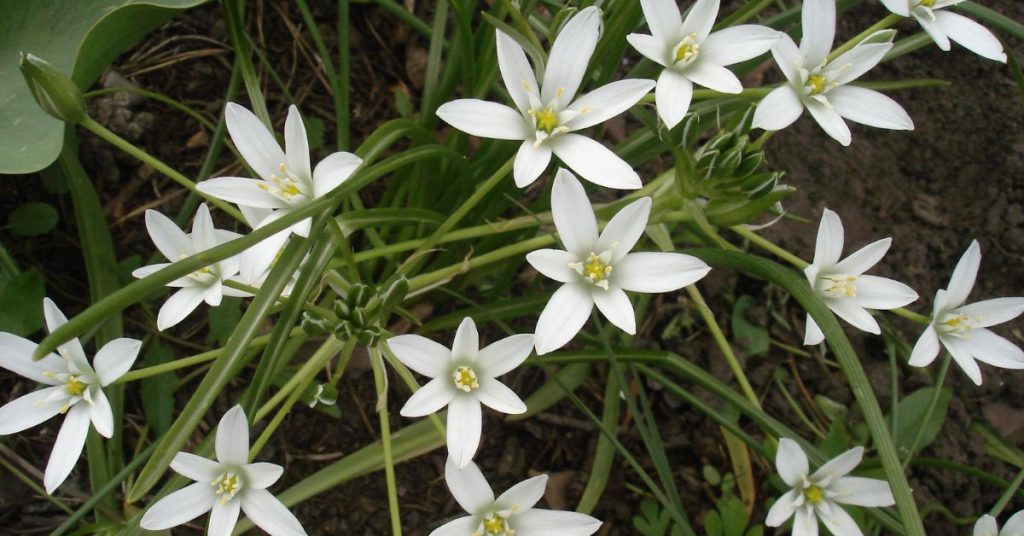
Star of Bethlehem, also called nap-at-noon, is a pretty, herbaceous perennial bulb plant known for its six-pointed white flowers.
- Grows 1-1.5 feet tall on slender stems lined with grass-like leaves.
- Flowers have six white petal-like tepals and a green stripe on the underside. Bloom in spring.
- Native to Europe and parts of the Mediterranean. Naturalized as a wildflower in some areas.
- Grows from a poisonous bulb. Do not ingest any part of this plant.
- Does well in part shade gardens with moist, well drained soil. Avoid wet sites.
- Works nicely alongside other spring bloomers like bleeding hearts and ferns.
- Remove spent flower stems to improve appearance. Divide crowded clumps in fall.
Showy Stonecrop
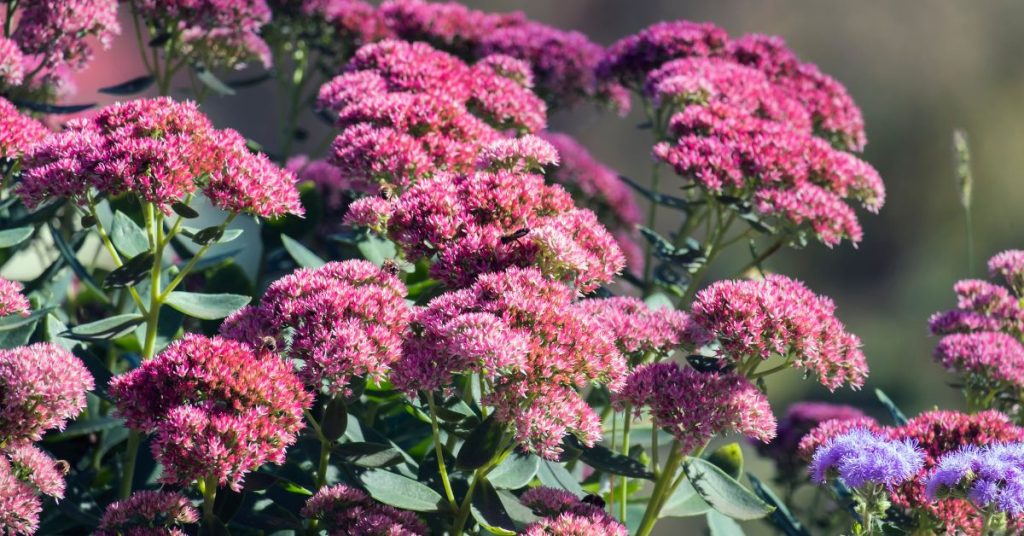
Showy stonecrop, also called ice plant, is a low-growing succulent perennial prized for its brightly colored summer flowers.
- Native to alpine regions of Europe and Asia. Thrives in hot, sunny areas.
- Fleshy light green leaves on spreading 6-10 inch tall stems. Goes dormant in winter.
- Clusters of daisy-like blooms in pink, red, orange, yellow or white. Long bloom season.
- Tolerates poor, dry soils. Does well in rocky areas, rock walls, and green roofs.
- Works great for borders, beds, containers. Allow room to spread.
- Avoid overwatering. Drought tolerant once established. Not fond of humid climates.
- Few pest or disease problems. Deer resistant. Can remove old foliage and stems as needed.
Skullcap
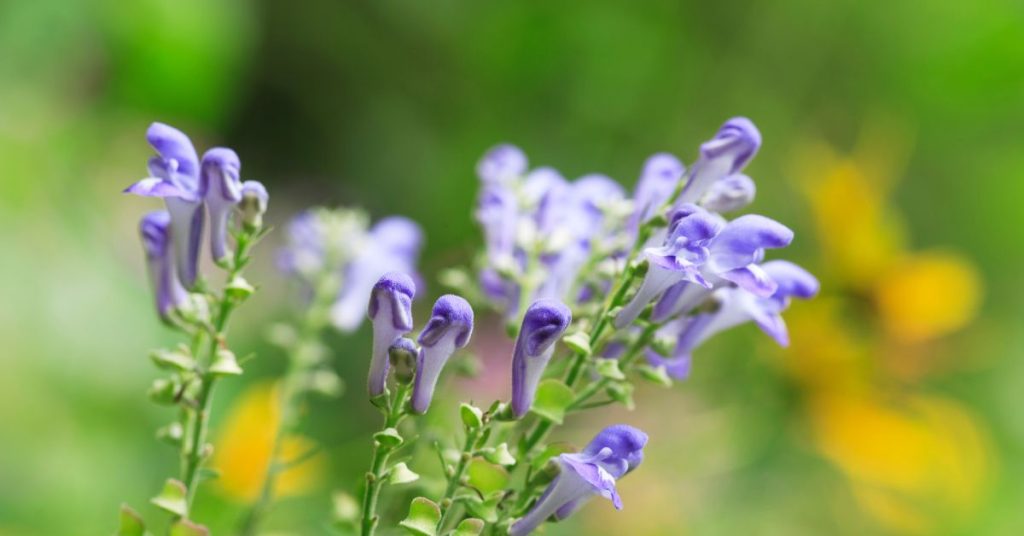
Skullcap refers to over 200 species of hardy perennial flowers in the mint family Lamiaceae. Features:
- Clusters of small, blue or purple flowers on 1-2 feet tall plants. Blooms in summer.
- Leaves are lightly hairy and typically heart or spade shaped.
- Native to North America, China, and Europe. Used in traditional medicines.
- Does well in partial sun to full shade. Tolerates a range of soil types.
- Good for woodland gardens and shady borders. Attracts pollinators.
- Can be aggressive spreader. Contain by growing in pots.
- Best pruned back after flowering to maintain appearance.
- Varieties offer pink blooms or variegated foliage. Avoid Medicinal use without guidance.
Soapwort

Soapwort refers to perennial flowering plants like Saponaria officinalis, prized for their delicate pink-white blooms and use as a natural cleaner.
- Native to Europe and Asia. Naturalized in some US states.
- Features clustered pink or white five-petaled flowers on 1-2 foot plants.
- Blooms summer to fall. Does well in full sun to partial shade.
- Tolerates poor soil but requires good drainage to thrive.
- Leaves and roots can be agitated in water to create a natural sudsy soap.
- Used historically for washing delicate fabrics. Contains saponins.
- Works well in cottage gardens, borders, meadows. Attracts butterflies!
- Can spread vigorously by seed. Deadhead faded blooms to curb reseeding.
Shrub Rose

Shrub roses offer diverse options for brightly colored, repeat-blooming roses without the fuss of climbing types.
- Range from 2-6 feet tall and wide. Most flower from spring to fall frost.
- Once-blooming older types offer June flowers and rose hips.
- Modern reblooming shrub roses offer recurrent flowers all season.
- Choose based on flower color, growth habit, hardiness, and scent.
- Require at least 6 hours of sun and well-drained soil. Avoid wet feet.
- Prune oldest canes by 1/3 each spring to improve flowering and shape.
- Watch for common rose troubles like powdery mildew, rust, spiders, and black spot fungus.
- Use in borders, hedges, foundations. Knock Out, Drift, Oso Easy are excellent carefree choices.
Saffron
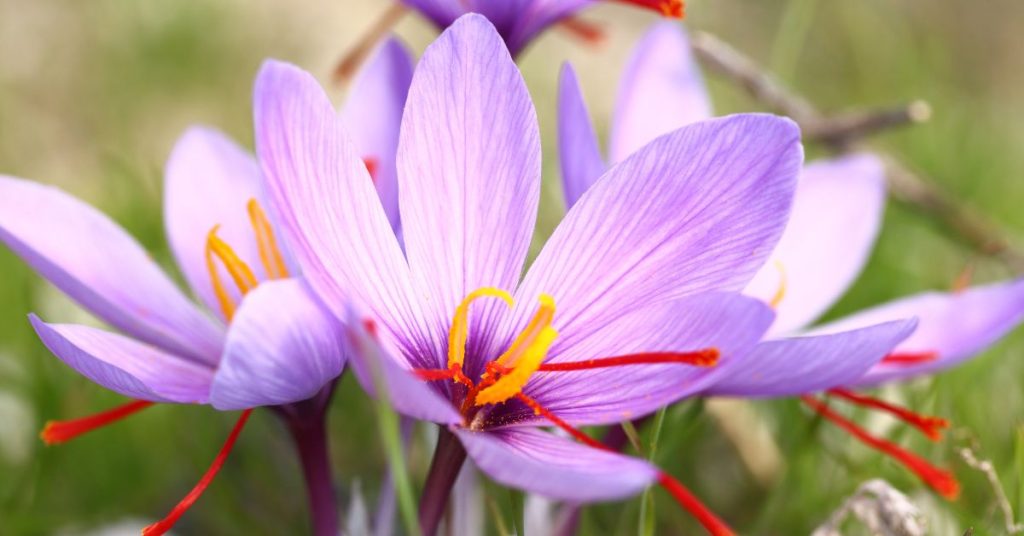
Saffron is a fall-blooming herbaceous perennial flower known as the world’s most expensive spice.
- Grows 4-8 inches tall on thin grass-like leaves. Produces delicate purple flowers in autumn.
- The dried red stigmas from inside the flowers are hand harvested and dried to make saffron spice.
- Native to Greece and the Mediterranean. Takes 3 years from planting before flowering.
- Grow from corms planted 2-4 inches deep in well drained soil in full sun. Dig up and divide every 2-3 years.
- Flowers bloom in fall for about 2-3 weeks. Pick stigmas daily, early morning.
- Labor intensive to harvest, requiring many flowers for a small amount of spice.thus the high cost.
- Imparts a golden color and unique flavor to foods. Use sparingly.
Siberian Iris
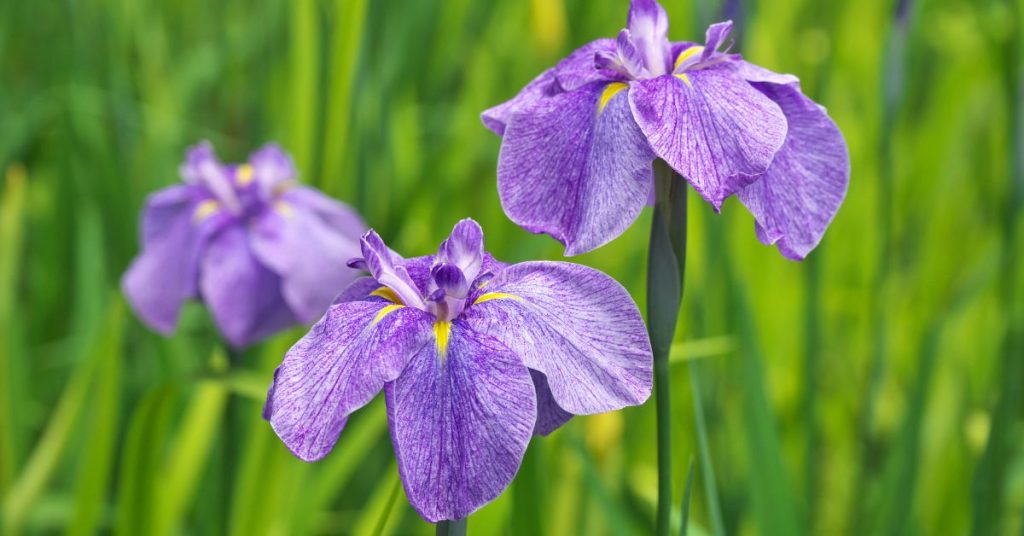
Siberian iris is a hardy, low-maintenance perennial flower perfect for borders and cutting gardens.
- Native to central and eastern Europe and Russia.
- Features showy purple, blue, white or bi-color blooms on slender 2-3 foot tall stalks in late spring.
- Grass-like foliage remains attractive all season long. Goes dormant in winter.
- Tolerates wet soil but also adapts to many conditions. Does best in full sun.
- Deer and rabbit resistant perennial. Useful for rain gardens and near ponds.
- Divide clumps every 3-4 years in summer to promote flowering. Can propagate by seed.
- Makes beautiful cut flowers. Pick blooms as flowers start to open for longest vase life.
Sand Phlox
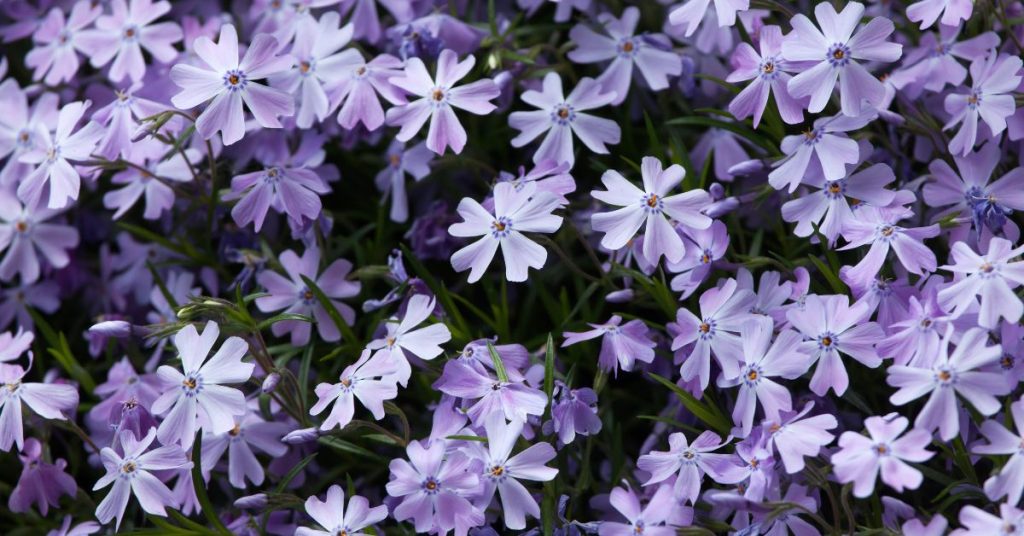
Sand phlox is a spreading perennial wildflower that blankets areas with vibrant flowers in spring.
- Also called moss phlox. Grows just 4-6 inches tall, spreading 1-2 feet wide.
- Features colorful flowers in pink, purple, blue, and white. Some bicolors exist.
- Native to eastern and central US. Thrives in nutrient poor, sandy or gravelly soils.
- Does well in full sun and dry conditions. Looks lovely in rock gardens.
- Spreads easily to form an attractive flowering groundcover. Works great between pavers.
- Prune lightly after blooming to tidy up. Avoid cutting back hard.
- Deer and rabbit resistant once established. Attracts butterflies and pollinators!
Spiked Speedwell

Spiked speedwell is a pretty, short-lived perennial flower that blooms in late spring and early summer.
- Grows 1-2 feet tall on leafy spikes covered in hundreds of tiny blue flowers with white throats.
- Thrives in partial sun to full shade. Does well under trees and shrubs.
- Native to Europe and Asia. Naturalized in some parts of North America.
- Works great in shady wildflower meadows, woodland gardens, and perennial borders.
- Prune back after blooming to encourage a second flush of flowers.
- Speedwell species are considered weeds by some, but provide food for pollinators.
- Can be aggressive self-seeders. Deadhead spent blooms to prevent excessive spread.
- Deer tend to avoid this plant. Has few issues with pests or disease.
Scarlet Strawberry
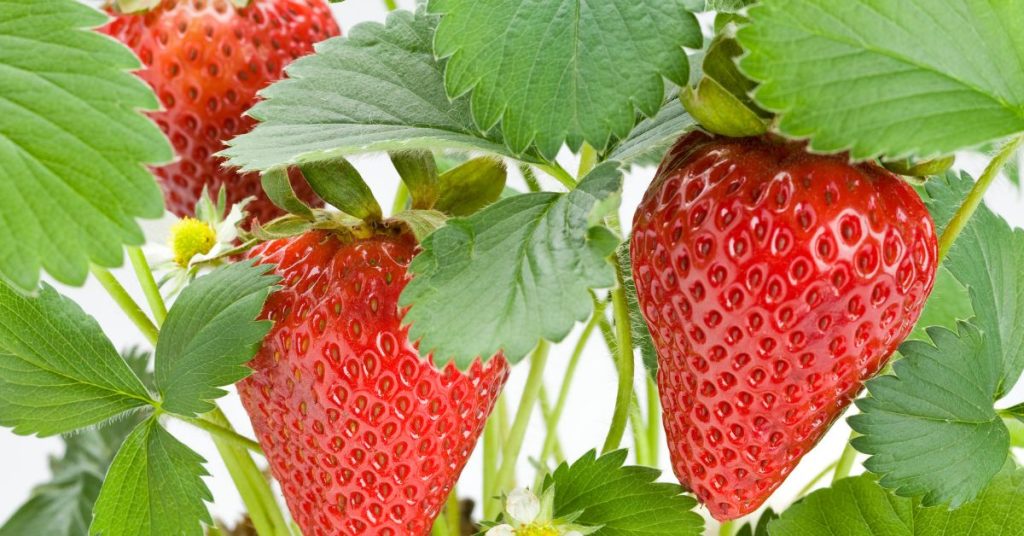
Scarlet strawberry is a eye-catching wildflower that blooms in late spring with vivid red berries through fall.
- Perennial that grows 6-12 inches tall on lance-shaped green leaves.
- Native to Eastern and Central U.S. Found in woodlands and along streams.
- Features bright red 1/2 inch wide blooms that give way to scarlet berries.
- Does well in part shade with consistent moisture. Avoid hot afternoon sun.
- Makes a nice groundcover. Watch for spreading via runners.
- Berries are edible with mild flavor. Attracts birds and wildlife.
- Use in shade gardens, woodland settings, native plantings.
- Requires little care. Trim back runners to contain spread if needed.
Siberian Bugloss

Siberian bugloss is an attractive herbaceous perennial flower featuring vivid blue blooms.
- Grows 2-3 feet tall on hairy green stems lined with lance-shaped leaves.
- Produces showy clusters of bell-shaped flowers in vivid sky blue. Blooms in early summer.
- Does best in full sun and dry to medium moisture, well-draining soil. Drought tolerant.
- Native to steppe regions of Southeastern Russia and Northwest China.
- Works well in borders, cottage gardens, meadows, and cut flower arrangements.
- Attracts bees, butterflies, and beneficial pollinators. Deer resistant.
- Can be short-lived. Allow some seeds to drop to ensure future plants.
- Avoid invasive spreading by removing spent blooms before they go to seed.
Scilla

Scilla are pretty bulb flowers that provide early season color. Popular types include:
- Siberian squill – Bright blue star-like flowers on 4-6 inch plants in spring.
- Wood squill – White starry flowers with blue stripe undersides. 6 inches tall.
- Spanish bluebell – Vibrant blue bell-like blooms on 1 foot stalks. Fragrant.
- Scilla peruviana – Bright blue conical flowers with yellow centers. 1 foot tall.
- Ideal for borders, rock gardens, and containers. Do well under trees.
- Plant bulbs in fall 4-6 inches deep and 3 inches apart in well-drained soil.
- Tolerate a range of conditions. Provide sun to part shade. Bloom time is short.
- Foliage dies back after blooming. Mix with other spring ephemerals.
- Rodents and deer tend to avoid these bulbs. Few pest or disease issues.
Spider Lily
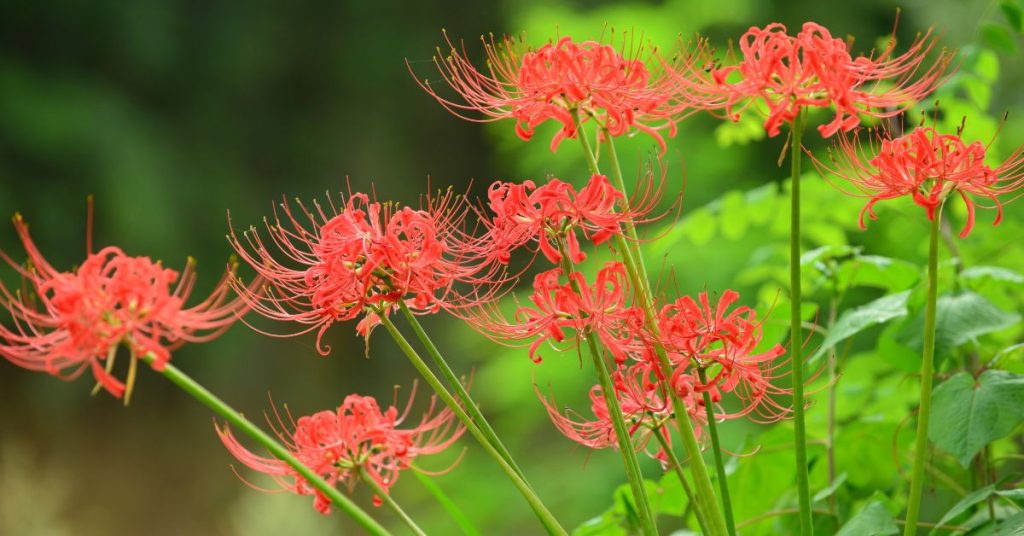
Spider lily is a unique plant that earns its name from the spider-like shape of its flowers.
- Perennial with narrow strap-like foliage and umbels of delicate flowers.
- Flowers have slender curly tepals that resemble spider legs. Come in white or pink.
- Native to Asia. Grows from bulbs 2-3 inches deep. 18-24 inches tall.
- Features long bloom period late summer into fall. Nice complement to mums.
- Does well in zones 7-10. Needs full sun to part shade and moist well-draining soil.
- Lovely alongside borders, ponds, and in containers. Attracts butterflies.
- Tolerates short periods of drought once established. Mulch to keep roots cool.
- Bulbs spread slowly by offsets. Lift and divide when overcrowded.
Sorrel
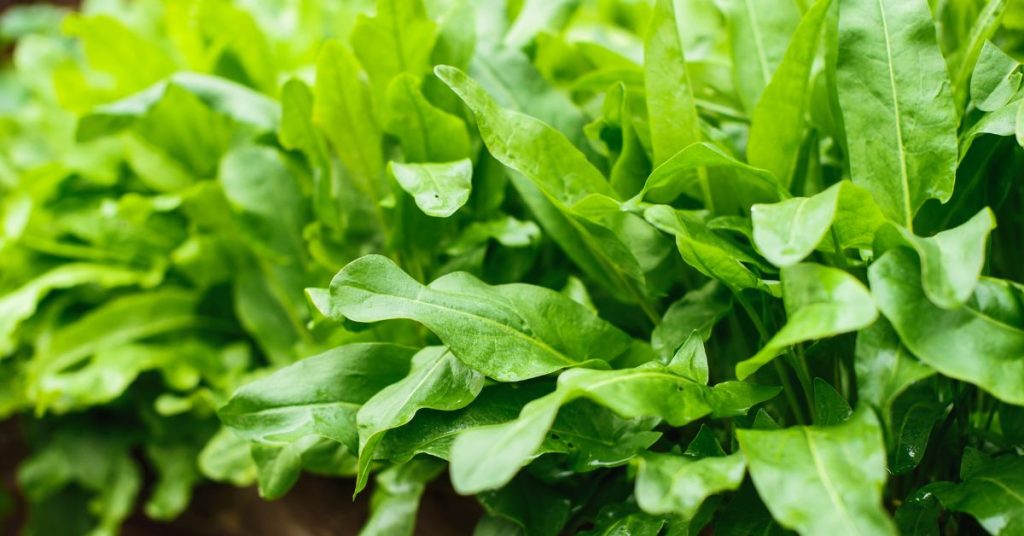
Sorrel is an old-fashioned perennial herb prized for its tart, lemony flavor. Flower features:
- Small greenish-white flowers that bloom in summer on 2-3 foot plants.
- The arrowhead-shaped leaves are the main culinary interest. Tangy lemon-apple flavor when young.
- Common sorrel (Rumex acetosa) has slender leaves. French sorrel has large, thick leaves.
- Thrives in cool weather. Tolerates partial shade. Best harvested early.
- Used fresh in salads, soups, sauces. Popular in French cuisine.
- Contains oxalic acid so cook before eating large amounts.
- Good for herb gardens, edible landscapes. Deter deer and rabbits.
- Keep soil moist for best growth. Cut back flower stalks to prolong harvest.
Scabiosa
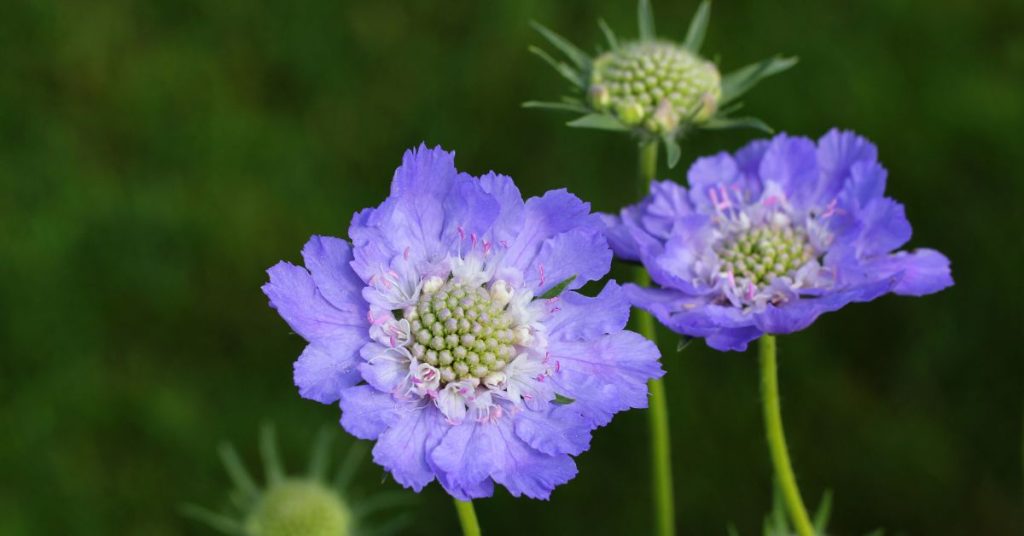
Scabiosa, commonly called pincushion flower, is a long-lasting bloomer for summer gardens.
- Features pom pom-like flower heads in white, pink, lavender, blue and purple. 2-3 feet tall.
- Native to Europe, Africa, and Asia. Thrives in full sun.
- Does well in borders, cottage gardens, cut flower arrangements, pollinator gardens.
- Deadhead spent blooms to encourage more flowering from midsummer to frost.
- Some species are annuals. Perennial types may be short lived – allow reseeding.
- Avoid wet soils. Tolerates drought once established. May need staking.
- Watch for fungal diseases if overwatered. Attracts beneficial insects.
- Good cut flowers. Sear the base of stems to prolong vase life.
Solomon’s Seal

Solomon’s seal is a graceful woodland perennial that produces dangling white blooms below arching foliage.
- Grows 3-4 feet tall from rhizomes. Features rows of green bell-like flowers.
- Lovely green and white variegated leaves. Provides nice texture contrast in gardens.
- Native to temperate forests in Asia, Europe, and North America.
- Thrives in part to full shade. Does well under trees and along woodland edges.
- Works well paired with ferns, hostas, bleeding hearts and other woodland plants.
- Can be aggressive spreader. Cut back spent blooms and contain rhizomes as needed.
- Slugs and deer may feed on the foliage if accessible. No serious pest/disease issues.
Sea Thrift
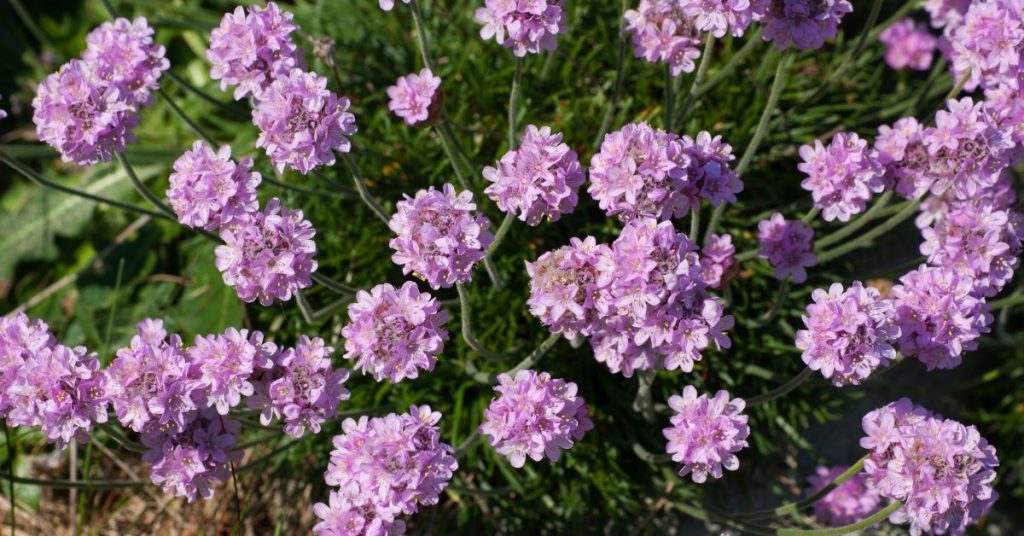
Sea thrift is a compact, mounding perennial that blankets itself with pinkish-purple flowers in spring.
- Hardy plant that grows 4-10 inches tall and spreads 1-2 feet wide.
- Does well in full sun and dry, sandy or rocky soils. Tolerates salt spray.
- Features evergreen needle-like foliage and clusters of nectar-rich blooms attractive to pollinators.
- Excellent choice for rock gardens, borders, coastlines. Works in containers.
- Shear back after initial flowering to encourage repeat blooms. Tidy up foliage as needed.
- Avoid wet soils which can lead to rot. Drought tolerant once established.
- Few serious problems with pests or diseases. Deer tend to leave this plant alone.
Scarlet Rose Mallow
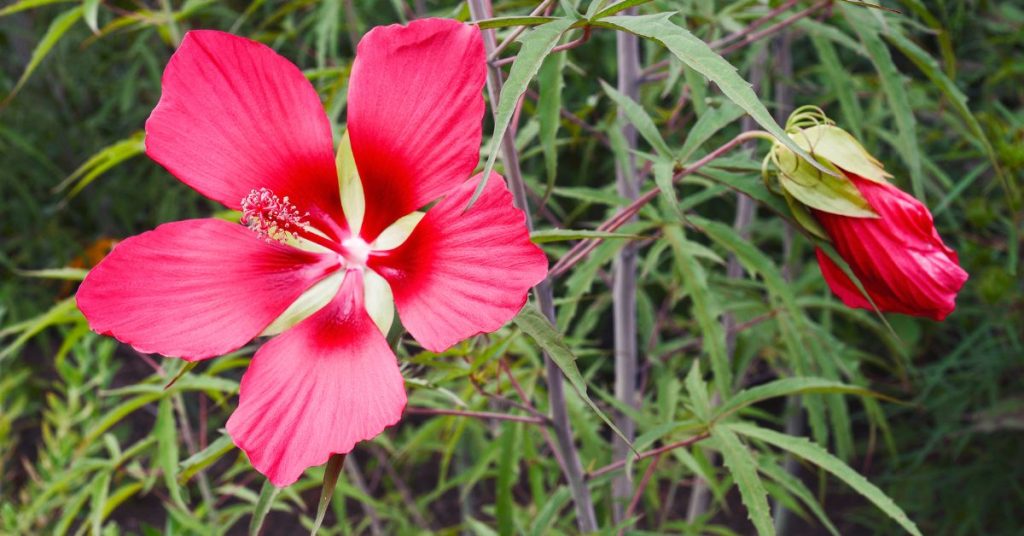
Scarlet rose mallow is a flowering hibiscus relative known for its vibrant red blooms.
- Perennial that grows 2-4 feet tall with gray-green leaves.
- Large, hollyhock-like flowers emerge crimson red then fade to pinkish white.
- Blooms from midsummer into fall. Does well in hot, humid climates.
- Native to China. Thrives in full sun to part shade and moist, fertile soil.
- Does well in borders, cottage gardens, containers, and pond/bog edges.
- Prune back old stems in spring to encourage new growth. Mulch roots in winter.
- Watch for aphids, spider mites, caterpillars, and fungal issues if overwatered.
- Attracts hummingbirds and butterflies! Excellent nectar source.
Southern Blue Flag
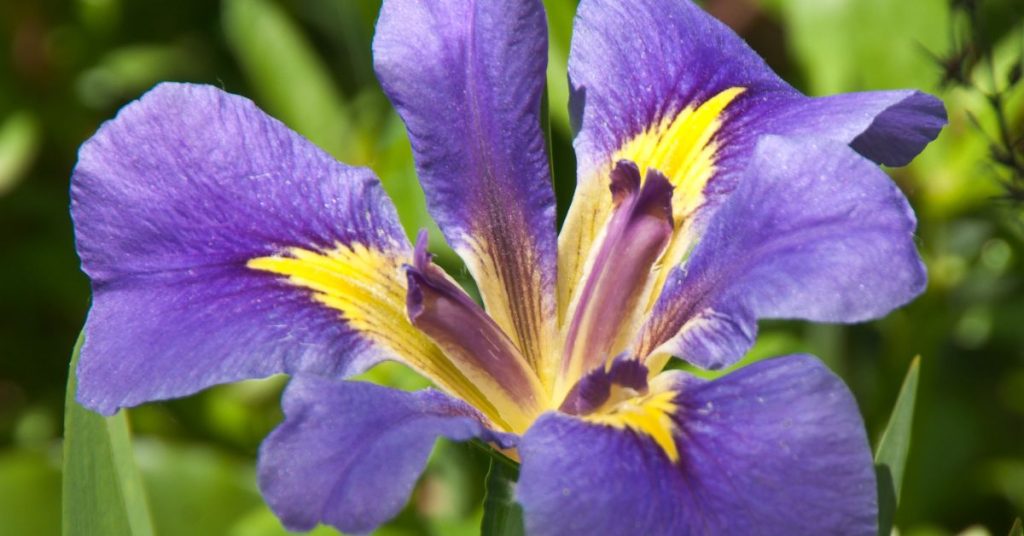
Southern blue flag is a showy native iris that brings striking color to sunny garden spots and pond edges.
- Clump-forming perennial growing 2-3 feet tall with sword-like leaves.
- Features large violet-blue flowers marked with yellow and white in late spring/early summer.
- Native to wetlands in southeastern U.S. Does well in consistently moist soil.
- Tolerates full sun but appreciates some afternoon shade in hot climates.
- Lovely in rain gardens, beside ponds/streams, or in containers. Hummingbird favorite!
- Remove spent flower stalks down to the leaves after blooming finishes.
- Resilient plant with few pests or diseases. May need division every 2-3 years.
Scarlet Buckeye

Scarlet buckeye is a showy, medium sized flowering tree that brightens up gardens in late spring.
- Deciduous tree growing 15-20 feet tall with rounded shape.
- Produces drooping panicles of tubular red flowers in spring before the leaves emerge.
- Palmate leaves turn attractive shades of yellow and orange in fall.
- Does best in moderately moist, acidic, well-draining soil. Tolerates some drought.
- Native to eastern U.S. Does well in part sun to full sun. Provide afternoon shade in hot climates.
- Lovely small ornamental tree for borders, foundations, rain gardens, native plantings.
- No serious insect or disease problems. Occasionally chlorosis in alkaline soils.
Snowdrop Windflower

Snowdrop windflower is one of the earliest blooming flowers, often pushing up through snow.
- Perennial growing 4-9 inches tall from bulb. Grass-like leaves.
- Nodding, bell-shaped white blooms appear in late winter/early spring. Delicate beauty.
- Native to Europe. Naturalized in woodland areas in some parts of North America.
- Does well in zones 3-8. Appreciates afternoon shade and humus-rich, moist soil.
- Lovely under trees paired with crocuses, winter aconite, and other early bloomers.
- Rodents and deer tend to avoid this plant. Slugs may chew on leaves.
- Best left undisturbed once established. Spreads slowly via self-seeding.
Serbian Bellflower
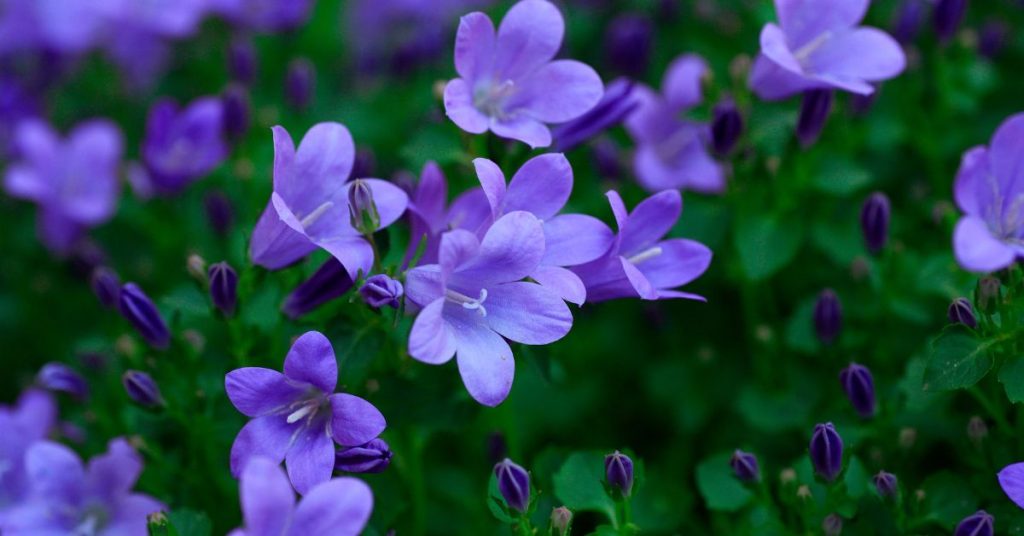
Serbian bellflower is an easy to grow perennial featuring masses of star-shaped purple blooms.
- Grows 18-24 inches tall on upright, hairy stems lined with lance-shaped leaves.
- Abundant purple flowers rise above foliage from early summer into fall. Deadhead for more blooms.
- Native to Southeastern Europe. Thrives in full sun to partial shade.
- Does well in borders, rock gardens, containers. Attracts bees, butterflies and hummingbirds!
- Heat and drought tolerant once established. Provide good drainage.
- May require staking if grown in too much shade or very rich soil.
- Generally pest and disease free. May be short lived – allow some seeds to fall.
Shasta Daisy
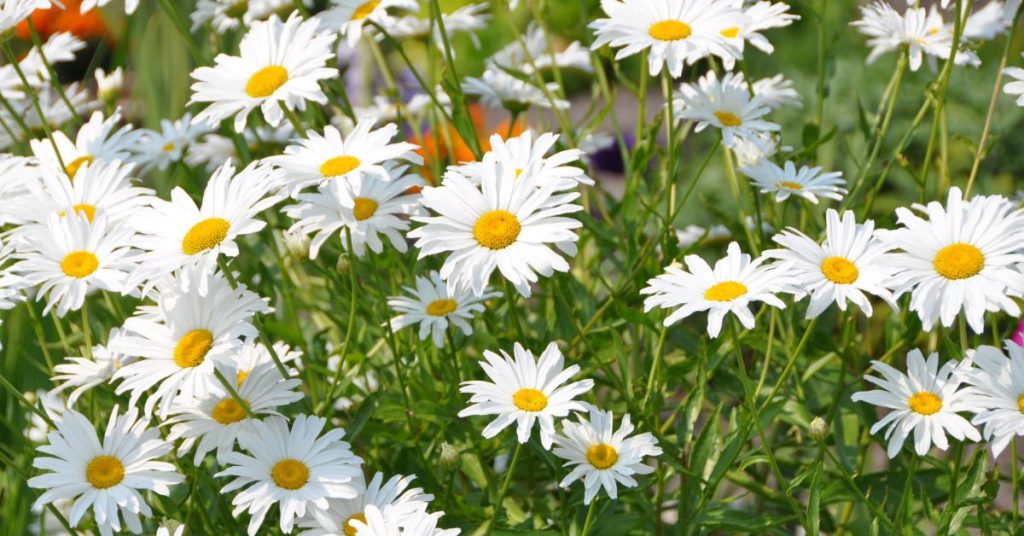
Shasta daisy is a classic perennial featuring large white blooms with golden centers all summer long.
- Grows 1-3 feet tall depending on variety. Forms bushy clumps of dark green leaves.
- Single daisy-like flowers 2-4 inches wide with white rays and yellow disks. Deadhead for more blooms.
- Does well in full sun and average, well-draining soil. Drought tolerant once established.
- Lovely in perennial borders and fresh-cut flower bouquets. Great for beginners.
- Dig up and divide the clumps every 2-3 years in spring to rejuvenate growth.
- Minimal care required. May get powdery mildew fungus or leaf spot diseases.
Shooting Star Flower
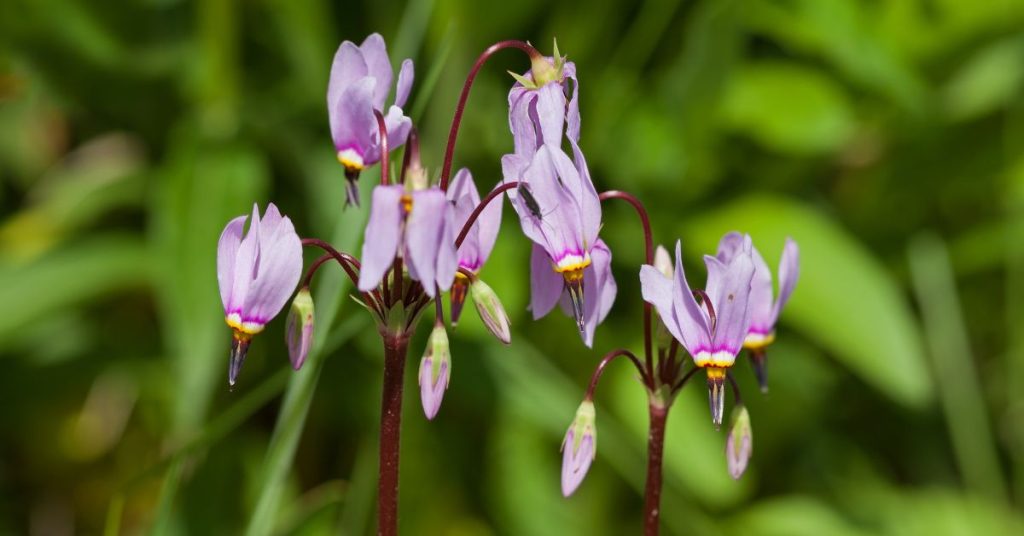
Shooting star is a delicate woodland wildflower that lights up shady gardens in spring.
- Grows from a rhizome to form clumps 6-12 inches tall.
- Features nodding, bell-shaped blooms in white or pink with curled back petals like a star.
- Native to US and Canada. Does well in dappled shade and moist, humus-rich soil.
- Lovely under trees or along woodland edges. Works well with ferns, bleeding hearts, and trillium.
- Spreads slowly. Plant tubers or transplant seedlings for propagation.
- Foliage dies back after spring blooms fade. Mark location to avoid disturbing.
- Deer rarely damage this plant. Watch for slugs and snails on the foliage.
You May Also Like:
- Flowers that start with T
- Flowers that start with U
- Flowers that start with V
- Flowers that start with W
